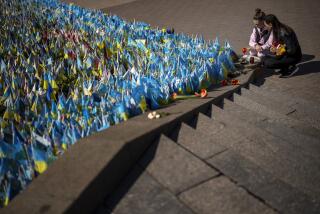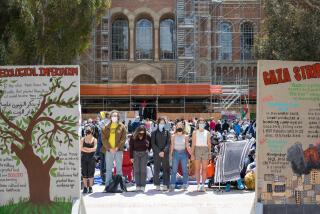Unfinished Business in a War Zone
More than 30 years after Barry Lee Hempel died in one of the Vietnam War’s least known but most disastrous battles, he is still waiting to come home.
The Garden Grove man was among 200 Americans killed or wounded in the battle of Kham Duc--and one of dozens whose bodies have not been recovered. But a first-of-its-kind task force plans a return to Vietnam early this year with hopes of finding the soldiers’ remains in the tangled jungles where they fell.
The senior photo in Garden Grove High School’s 1965 yearbook shows a smiling Hempel, looking like the quintessential Southern California teenager of the time, dressed in a white jacket and dark bow tie. His hazel eyes are bright with promise.
On May 10, 1968, Marine Pfc. Hempel found himself trapped with other Americans at Ngok Tavak, a jungle outpost near the Vietnam-Laos border. The early morning attack triggered three days of carnage.
Thirteen Marines in Hempel’s 33-man platoon died in the North Vietnamese assault at Ngok Tavak. Twelve more Marines, including Hempel, and two Army Special Forces troopers, including Army Sgt. Glenn E. Miller of Oakland, were listed as missing in action. Their remains were never recovered.
At Kham Duc, a Special Forces camp five miles away that gave the battle its name, 18 more soldiers and airmen were left missing in action.
The MIA count of 32 was the largest of any battle in the war, according to Vietnam Veterans of America. Four of the missing were from California, including Air Force Lt. Stephen C. Moreland of Los Angeles, who was co-piloting a C-130, and Army Spec. Richard Bowers of Long Beach, whose remains were recovered in 1970.
Last year, new hope arose that Hempel, Miller and some of the missing from Ngok Tavak might at last be found.
But while searchers are optimistic about their chances of eventual success, one Army veteran of the battle who returned to Kham Duc as part of the task force described the effort last year as a microcosm of the war itself: an optimistic beginning with a bitter ending.
“In Vietnam, you planned everything that was supposed to happen on a mission. But nothing ever turned out how it was planned,” said Bill Wright of Moore, Okla. “That’s what happened here. . . . I feel like I’ve failed them again.”
Big Buildup, Big Toll
Despite its obscurity, the battle of Kham Duc was extraordinary for its bloodshed. Army and Air Force reports show 10 aircraft were shot down, including two C-130 transport planes. One of those carried more than 150 Vietnamese civilians and crew--making it the worst loss of life in aviation history at the time.
Many wonder whether the staggering toll could have been avoided. Senior U.S. commanders in Saigon and Da Nang knew months before that the North Vietnamese army was building roads in Laos and stockpiling equipment for an attack on Kham Duc but vacillated on how to counter the enemy threat, records show.
For Wright, 50, the return trip evoked terrifying memories of a battle that was among America’s costliest defeats in Vietnam. In a frantic effort to evacuate survivors through a gantlet of antiaircraft fire, U.S. commanders abandoned the bodies of dead soldiers.
Wright, a postal employee, has relived the battlefield nightmare for three decades.
About 3,000 enemy troops surrounded Wright’s reconnaissance platoon of 35 soldiers strung out on three hilltops above Kham Duc, where about 750 U.S. troops reinforced by about 200 South Vietnamese militia defended the camp below.
Night after night he sees the terrified faces of men barely out of their teens screaming for help and dying on a fog-shrouded hilltop. They are the ghosts of U.S. soldiers whose faces have not aged with time. Their futile screams, muffled by gunfire and the frenzied shouts of victorious North Vietnamese soldiers, still resonate in his mind.
Wright, a radio operator with the 2nd Battalion 1st Infantry, and another GI escaped from a hilltop where other members of a 10-man squad were holding out, wounded but alive. Already two squad members had been killed in the assault.
Then came an order for Wright to do the unthinkable: Call an airstrike on the hill, allowing U.S. warplanes to bomb everyone in the area, including their own troops. Just 20 years old, Wright begged his battalion commander to rescind the order.
“My protests didn’t make any difference. I radioed the guys in a bunker to tell them what was going to happen,” Wright recalls. “They started yelling and screaming, ‘Don’t do it! . . . You’ve got to get back and help! We’re all wounded!’ ”
The airstrike began, and two F-4 Phantoms flew out of the clouds, dropping bombs on the hilltop observation post.
Wright shudders at the recollection.
“There was smoke and debris all over,” he said. “Then I didn’t hear from them again.”
The surviving members of Wright’s squad were trapped in a bunker and made it through the bombing, but three were later killed by Communist troops while trying to escape to U.S. lines and are listed as MIAs. Two others were luckier, making it back. Another man was taken prisoner and repatriated in 1973.
U.S. government officials would not address the circumstances of what happened at Kham Duc because it occurred three decades ago. Many of the men who played a key role in planning the battle are dead.
But history professor James R. Reckner, director of the Vietnam Center at Texas Tech University in Lubbock, said it was not uncommon in the Vietnam War for battlefield commanders to order air or artillery strikes against the enemy when they were atop U.S. troops.
The strategy of the Viet Cong and North Vietnamese army “was to get as close to our lines as possible. There were a number of incidents throughout the war when this happened, and U.S. casualties resulted from friendly fire that was called on the enemy,” said Reckner, also a Vietnam veteran.
Feeling ‘Tons of Guilt’
In June, the Pentagon’s Joint Task Force-Full Accounting returned to Kham Duc to comb the battlefield for the missing Americans’ remains. But the area, now overgrown with thick jungle greenery, could not be excavated because the Vietnamese authorized the Americans to remain in the area for only a limited time.
In September, the group had better luck at Ngok Tavak. Task force spokesman Lt. Col. Franklin Childress said the team recovered teeth, bone fragments and personal items including wallets, a watch and three pairs of U.S. jungle boots.
The unidentified American remains were returned Nov. 6 to the United States. A more thorough excavation is scheduled at the site in the next two months, Childress said.
Formed in 1992, the task force investigates cases of Americans missing from the Vietnam and Korean wars and World War II. The group--160 men and women from all branches of the military, along with civilian archeologists and anthropologists--excavates old battlefields for the remains of American servicemen.
There are still 2,078 Americans missing from the Vietnam War. Since U.S. involvement ended in 1973, 505 missing servicemen have been identified through DNA testing and dental records. Childress said the task force schedules five missions annually in Vietnam and Laos and one in Cambodia.
Among those on the Pentagon team at Kham Duc and Ngok Tavak last summer were Wright and Jim McLeroy of Scottsdale, Ariz., also an Army veteran of the battle. They were the first civilian Vietnam veterans to accompany the task force overseas, guiding it to the battlefield where U.S. soldiers fell.
Wright, who earned a Silver Star for bravery in the battle, made himself a promise after the battle of Kham Duc: He would return and find the remains of the men from his platoon who died on that night, May 12, 1968.
“I always knew I was going to go back there, to that place,” Wright said. “I felt tons of guilt. I had run off and left them. The battalion ran off and left them, and then the country ran off and left them.”
Wright remembered Kham Duc as a village of grass huts and 200 people. But when he returned in June, he was shocked to find a town of 5,000 and electric power lines strung over the mountains. A giant poster celebrating the 30th anniversary of the Communist victory at Kham Duc hung from a wall.
He met with Vietnamese veterans of the battle, including an old man who had operated one of the many Communist mortars that killed and wounded dozens of Americans.
Wright wondered the inevitable as he faced the ancient Vietnamese warrior.
“Was I looking at the man who killed some of my friends? I didn’t have any animosity for him. But I wanted to know,” said Wright, who had no way to find out.
If the Pentagon will allow him, he will go again to join in the search because he got so close the first time. The ghosts of Wright’s buddies, he said, were there.
“I could feel their presence, but I couldn’t touch them. It was so frustrating.”
A Mother’s Wounds
Pentagon officials said they are optimistic about finding the remains of Hempel, Miller and other Americans who died at Ngok Tavak.
Hempel, who was 20, had been with the unit--D Battery 2nd Battalion 13th Marines--only about three months, but he had seen enough of Vietnam to know that he probably was not coming home.
“Barry didn’t have a lot of confidence about returning home. He talked about that a lot,” said Dell Scott of St. Cloud, Minn.
Hempel, 6 feet tall and 185 pounds, was muscular and athletic. He had been a starter on the Argonauts football team his junior and senior years.
“Barry was a good-looking kid with huge arms. Looked like a jock who high school girls go for,” said Tim Brown of Dallas.
Hempel’s mother, who lives in a group home with Gold Star mothers--women who lost sons in the Vietnam War--said talking about her son stirred too many painful memories.
“Barry was adopted by us. . . . Nobody ever loved a son more,” she said in a brief conversation last year.
Chicago resident Dave Fuentes remembers seeing Hempel lying in a pit during the battle. Fuentes, who had lost his helmet, put on Hempel’s and retrieved his dog tags.
“Barry was lying there so still. . . . I took his dog tags off and brought one back to [Da Nang] when we were evacuated and turned it in. I put the other one in his mouth,” Fuentes said. “I spent a couple of nights [in a fighting hole] with him. He was like the rest of us. Scared.”
More to Read
Sign up for Essential California
The most important California stories and recommendations in your inbox every morning.
You may occasionally receive promotional content from the Los Angeles Times.









